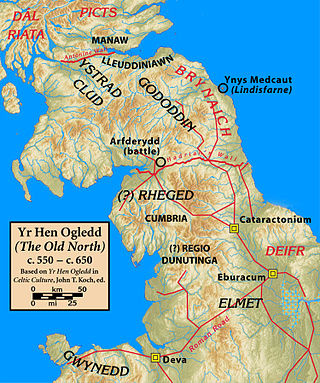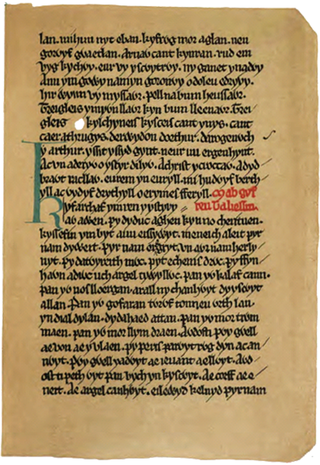Related Research Articles

Rheged was one of the kingdoms of the Hen Ogledd, the Brittonic-speaking region of what is now Northern England and southern Scotland, during the post-Roman era and Early Middle Ages. It is recorded in several poetic and bardic sources, although its borders are not described in any of them. A recent archaeological discovery suggests that its stronghold was located in what is now Galloway in Scotland rather than, as was previously speculated, being in Cumbria. Rheged possibly extended into Lancashire and other parts of northern England. In some sources, Rheged is intimately associated with the king Urien Rheged and his family. Its inhabitants spoke Cumbric, a Brittonic dialect closely related to Old Welsh.

Taliesin was an early Brittonic poet of Sub-Roman Britain whose work has possibly survived in a Middle Welsh manuscript, the Book of Taliesin. Taliesin was a renowned bard who is believed to have sung at the courts of at least three kings.

The Mabinogion are the earliest Welsh prose stories, and belong to the Matter of Britain. The stories were compiled in Middle Welsh in the 12th–13th centuries from earlier oral traditions. There are two main source manuscripts, created c. 1350–1410, as well as a few earlier fragments. The title covers a collection of eleven prose stories of widely different types, offering drama, philosophy, romance, tragedy, fantasy and humour, and created by various narrators over time. There is a classic hero quest, "Culhwch and Olwen"; a historic legend in "Lludd and Llefelys", complete with glimpses of a far off age; and other tales portray a very different King Arthur from the later popular versions. The highly sophisticated complexity of the Four Branches of the Mabinogi defies categorisation. The stories are so diverse that it has been argued that they are not even a true collection.

Ida is the first known king of the Anglian kingdom of Bernicia, which he ruled from around 547 until his death in 559. Little is known of his life or reign, but he was regarded as the founder of a line from which later Anglo-Saxon kings in this part of northern England and southern Scotland claimed descent. His descendants overcame Brittonic resistance and ultimately founded the powerful kingdom of Northumbria.
Aneirin, also rendered as Aneurin or Neirin and Aneurin Gwawdrydd, was an early Medieval Brythonic war poet who lived during the 6th century. He is believed to have been a bard or court poet in one of the Cumbric kingdoms of the Hen Ogledd, probably that of Gododdin at Edinburgh, in modern Scotland. From the 17th century, he was usually known as Aneurin.
Owain mab Urien was the son of Urien, king of Rheged c. 590, and fought with his father against the Angles of Bernicia. The historical figure of Owain became incorporated into the Arthurian cycle of legends where he is also known as Ywain, Yvain, Ewain or Uwain. In his legendary guise he is the main character in Chrétien de Troyes's Yvain, the Knight of the Lion and the Welsh Romance Owain, or the Lady of the Fountain, which corresponds to Chrétien's poem.

The Book of Taliesin is one of the most famous of Middle Welsh manuscripts, dating from the first half of the 14th century though many of the fifty-six poems it preserves are taken to originate in the 10th century or before.

Y Gododdin is a medieval Welsh poem consisting of a series of elegies to the men of the Brittonic kingdom of Gododdin and its allies who, according to the conventional interpretation, died fighting the Angles of Deira and Bernicia at a place named Catraeth in about AD 600. It is traditionally ascribed to the bard Aneirin and survives only in one manuscript, the "Book of Aneirin".
Medieval Welsh literature is the literature written in the Welsh language during the Middle Ages. This includes material starting from the 5th century AD, when Welsh was in the process of becoming distinct from Common Brittonic, and continuing to the works of the 16th century.

Urien ap Cynfarch Oer or Urien Rheged was a sixth-century ruler of the territory known as Rheged. His existence is confirmed by a ninth-century history and eight praise-poems to him possibly to be dated to his lifetime, attributed to the poet Taliesin. Urien features in medieval literature from Wales as one of the most celebrated figures of Welsh legend down to today. Outside of the Welsh context, he eventually was transformed in Arthurian legend into the figure of king Urien of Garlot or Gore. His most celebrated son, Owain mab Urien, similarly gave his name to the character of Ywain.

Yr Hen Ogledd, meaning the Old North, is the historical region that was inhabited by the Brittonic people of sub-Roman Britain in the Early Middle Ages, now Northern England and the southern Scottish Lowlands, alongside the fellow Brittonic Celtic Kingdom of Elmet, in Yorkshire. Its population spoke a variety of the Brittonic language known as Cumbric which is closely related to, if not a dialect of Old Welsh. The people of Wales and the Hen Ogledd considered themselves to be one people, and both were referred to as Cymry ('fellow-countrymen') from the Brittonic word combrogi. The Hen Ogledd was distinct from the parts of Great Britain inhabited by the Picts, Anglo-Saxons, and Scoti.
Cynan Garwyn was king of Powys in the north-east and east of Wales, who flourished in the second half of the 6th century. Little reliable information exists which can be used to reconstruct the background and career of the historical figure. Available materials include early Welsh poetry, genealogies and hagiography, which are often late and of uncertain value.
Llywarch Hen, was a prince and poet of the Brythonic kingdom of Rheged, a ruling family in the Hen Ogledd or "Old North" of Britain. Along with Taliesin, Aneirin, and Myrddin, he is held to be one of the four great bards of early Welsh poetry. Whether he actually wrote the poems attributed to him is unknown, and most of what is known about his life is derived from early medieval poems which may or may not be historically accurate.
Dynod son of Pabo, better known as Dynod the Stout or Dynod Fawr was the ruler of a small kingdom in the North Pennines in the post-Roman Hen Ogledd. Regio Dunutinga was a minor kingdom or region in North Yorkshire mentioned in the Life of Wilfrid. P.N. Wood identifies this with the area of Craven.
Gwallog ap Llenog was possibly a sixth-century ruler of Elfed, a region in the wider area memorialised in later Welsh literature as the 'Old North'. The evidence for Gwallog's existence survives entirely from two poems of spurious date and several other references in semi-legendary genealogies and literature well beyond his era. If this later material is to be believed, he was a member of the Coeling, a family which is supposed to have been prominent across several kingdoms in northern Britain in the sixth century. He is probably best remembered for his role in the Historia Brittonum as an ally of Urien Rheged. As with many figures of this period, he attracted much interest in later Medieval Welsh literature.
Gweith Gwen Ystrat, is a late Old Welsh or Middle Welsh heroic poem found uniquely in the Book of Taliesin, where it forms part of the Canu Taliesin, a series of poems attributed to the 6th-century court poet of Rheged, Taliesin.

Aeron was a kingdom of the Brythonic-speaking Hen Ogledd, presumed to have been located in the region of the River Ayr in what is now southwestern Scotland. It existed during the post-Roman era, perhaps earlier, and disappeared before or during the 7th-century conquest of the region by the ascendant Kingdom of Northumbria.
Canu Llywarch Hen are a collection of early Welsh englyn-poems. They comprise the most famous of the early Welsh cycles of englynion about heroes of post-Roman North Britain.
Rhiainfellt, name variants including Rieinmelt and Rieinmelth, was a British princess of the royal house of the kingdom of Rheged, a part of the Hen Ogledd. Her name means "Lightning Maiden" or "Lightning Queen" in Old Welsh. She was a wife of Oswiu, King of Northumbria.

The House of Rheged or the House of Rhun was an informal royal dynasty who ruled in the brittonic Kingdom of Rheged. The line is traced back to Coel Hen whose descendants are often referred to as the Coeling. The dynasty includes Urien, King of Rheged and his son Sir Ywain a Knight of the Round Table in Arthurian legend.
References
- ↑ The Poems of Taliesin, ed. by Ifor Williams, trans. by J. E. Caerwyn Williams, Medieval and Modern Welsh Series, 3 (Dublin: The Dublin Institute for Advanced Studies, 1968).
- ↑ Mike McCarthy, 'The Kingdom of Rheged: A Landscape Perspective', Northern History, 48 (2011), 9–22 (p. 14), doi : 10.1179/174587011x12928631621159.
- ↑ Andrew Breeze, 'The Names of Rheged', Transactions of the Dumfriesshire and Galloway Natural History and Antiquarian Society, 86 (2012), 51-63 (p. 62).
- ↑ Cf. Andrew Breeze, 'Yrechwydd and the River Ribble', Northern History, 47 (2010), 319–28, doi : 10.1179/007817210x12738429860905.
- ↑ Cf. Andrew breeze, 'Lancashire and the British Kingdom of Rheged', Transactions of the Historic Society of Lancashire and Cheshire, 167 (2018), 1–19, doi : 10.3828/transactions.167.3
- ↑ As edited by Mary Jones on the basis of The Book of Taliesin, ed. by J. Gwenogvryn Evans (Llanbedrog, 1910).
- ↑ The Triumph Tree: Scotland's Earliest Poetry, AD 550–1350, ed. by Thomas Owen Clancy (Edinburgh: Canongate, 1998), pp. 80-81.